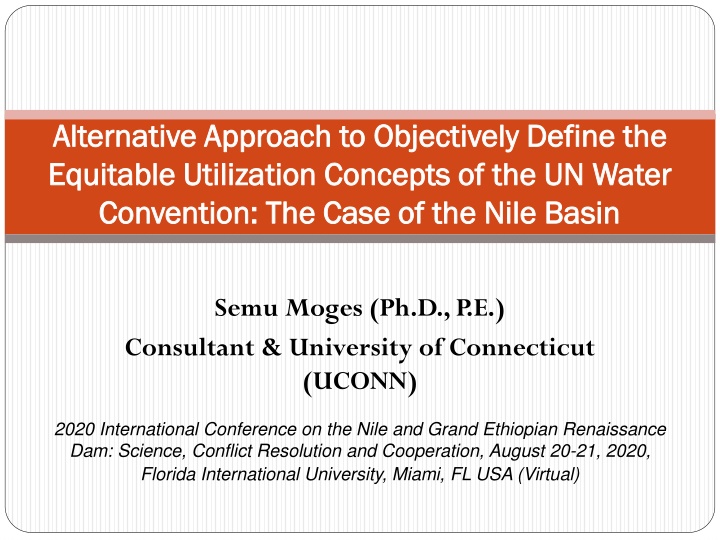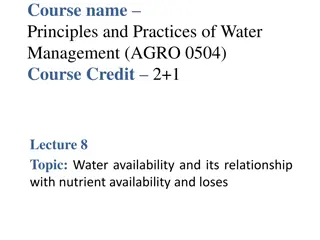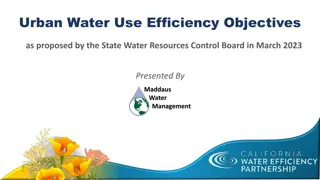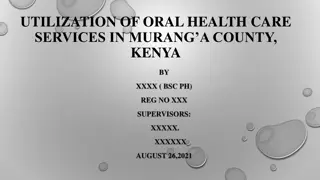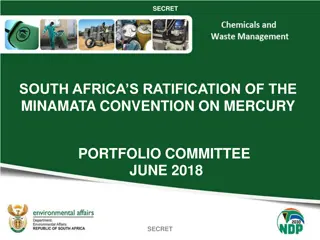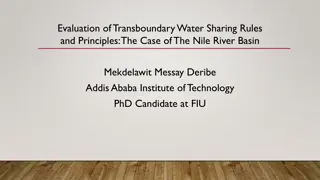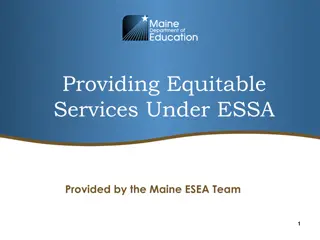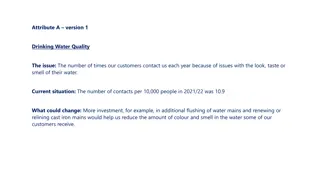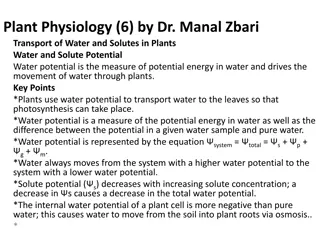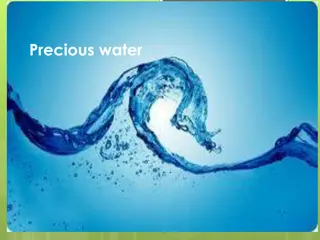Objectively Define Equitable Utilization Concepts of UN Water Convention: Case of Nile Basin
Alternative approach to objectively define the equitable utilization concepts of the UN Water Convention through the case of the Nile Basin. Delve into the concepts of equitable utilization and benefit sharing of shared water resources, addressing challenges and providing recommendations.
Download Presentation

Please find below an Image/Link to download the presentation.
The content on the website is provided AS IS for your information and personal use only. It may not be sold, licensed, or shared on other websites without obtaining consent from the author.If you encounter any issues during the download, it is possible that the publisher has removed the file from their server.
You are allowed to download the files provided on this website for personal or commercial use, subject to the condition that they are used lawfully. All files are the property of their respective owners.
The content on the website is provided AS IS for your information and personal use only. It may not be sold, licensed, or shared on other websites without obtaining consent from the author.
E N D
Presentation Transcript
Alternative Approach to Objectively Define the Alternative Approach to Objectively Define the Equitable Utilization Concepts of the UN Water Equitable Utilization Concepts of the UN Water Convention: The Case of the Nile Basin Convention: The Case of the Nile Basin Semu Moges (Ph.D., P.E.) Consultant & University of Connecticut (UCONN) 2020 International Conference on the Nile and Grand Ethiopian Renaissance Dam: Science, Conflict Resolution and Cooperation, August 20-21, 2020, Florida International University, Miami, FL USA (Virtual)
Table of Content Table of Content The concept of Equitable Utilization and Benefit sharing of the Shared Water Resources Approach/Methodology 3. Assessment of water for basic human needs: Water For Food Basic Food Needs 4. Preliminary results at 2015 5. Assessment of the Non-Reserved (Economic) Water Resources 6. Challenges to the application of the Methodology 7. Conclusion and Recommendation 1. 2.
1. The 1. The concept of Equitable Utilization and concept of Equitable Utilization and Benefit sharing of the Shared Water Resources Benefit sharing of the Shared Water Resources Equitable Utilization: It is the right of all Individuals living within countries of shared Water Resources to be entitled for basic human needs equally Benefit Sharing: It is the right of riparian countries to benefit from the shared water resources for economic development equitably NBI Vision also incorporates such terms To achieve sustainable socio-economic development through equitable utilization of, and benefit from, the common Nile Basin Water Resources
1. What 1. What does this mean? does this mean? Does it mean equitable allocation of the water resources to the riparian countries or equitable sharing of the benefits derived from the water resource? How does this be achieved? How can it be quantified? This research experimental and tries to indicate objective quantification of these questions
2. Approach/Methodology 2. Approach/Methodology Principle: Based on the UN Convention on the Law of the Non-Navigational Use of International Watercourses (1997) To provide a framework for negotiations between countries sharing an international water resource. One of the convention defines the obligation 1. - The right to reasonable and equitable use/share as co-equal criteria for the allocation of water between riparian countries - Without causing appreciable harm to Watercourse States
2. 2. Operationalizing Operationalizing the approach the approach Shared Water Resources 2. For Economic Development 1. For Basic Human Needs Equitable and Reasonable Share Without Appreciable Harm The right of Riparian's access to development Equitably Economic good The right of Individual equal access to basic human needs Social Good Non-Reserved Reserved Benefit/Water Sharing Water Sharing
2. Implementation 2. Implementation of the of the Approach Approach 2015 Baseline Population* (Nile Basin part of Population) 1. Assessment of the basic water needs of each riparian countries. 1.1 Water requirement to fulfill the minimum food/calorie requirement 1.2 Requirement for Domestic Water Supply 1.3 Requirement for Livestock production 1.4 Requirement for Basin Industrial goods 2. Separating the Reserved (social) and Non reserved (economic) part of the shared water resources 3. *In all the slides Sudan = (South Sudan + The Sudan)
3. Assessment of water for basic human needs: 3. Assessment of water for basic human needs: Water Water For Food Basic Food Needs For Food Basic Food Needs From the World Bank policy study from the year 1986: Food security is access by all people at all times to enough food for an active, healthy life. UN World Food Council, 1988, has a more general definition: Adequate food available to all people on a regular basis Reardon and Matlon, 1989, propose a limit or a value for a measurement of food insecurity: Consumption of less than 80% of WHO average required daily caloric intake. UNICED, 1990, points out the meaning of the sustainability: The assurance of food to meet needs throughout every season of the year. FAO, 1998, The human right to adequate food and freedom from hunger - Therefore, the minimum per capita calorie requirement was considered as the basic requirement 2700cal/cap/day
3. Assessment of water for basic human needs: 3. Assessment of water for basic human needs: Water For Food Basic Food Needs For Food Basic Food Needs Water According to IWMI (2004) water required to produce 1 kg of cereals food item is in the range of 0.4 to 3 m3 (1 kg maize contains 3650 calories) Using this concept and taking 2700 cal as minimum acceptable level of per capital calorie supply for each country, the required water for food security for each respective basin countries is estimated based on this consideration Note that some countries have per capita calorie abve this value,
3. Assessment of water for basic human 3. Assessment of water for basic human needs: needs: Domestic Water Supply Domestic Water Supply The quantity of water required for domestic purposes can be divided as: i) Drinking ii) cooking and iii) bathing According to Rangwala (2000) World s average urban water consumption per capital is about 150 liters per day or about 55m3 per year the world s average rural consumption per capital is only 50 liters per day and about 18m3 per year. Using this concept the basin population is divided into Urban and Rural and Domestic water estimated
3. Assessment of water for basic human needs: 3. Assessment of water for basic human needs: Water Water Requirement for Livestock Requirement for Livestock More than 58 million tropical livestock units (TLU) comprising cattle, sheep, goats, camels, horses, donkeys, pigs and poultry occupy the Nile Basin (IWMI, 2006) One TLU equals 250kg of live animal weight About 450 m3 of water is required annually to produce feed to maintain one TLU Feed production to maintain these animals requires about 26 billion m3/year of water
3. Assessment of water for basic human 3. Assessment of water for basic human needs: needs: Industrial Industrial Water Requirement Water Requirement Although industries considered as economical benefit, the basin population needs basic industrial products for their daily consumption and ingredients for cooking their food For such situation moderate factories needs 50 liters per kg of their product (Rangwala 2000). Using the concept of Rangwala, water for basic industrial use of the basin country estimated and presented
4. Preliminary results at 2015: 4. Preliminary results at 2015: Food Requirement Requirement Minimum Per capita Calorie requirement Food Per capital Daily Calorie intake (2000-2003) 3340 4000 2700 2380 2260 2150 2070 3000 1940 1840 1640 1610 1520 Calorie 2000 1000 0 Kenya Uganda Egypt Sudan Tanzan Burundi Rwand Ethiopi Eritrea DRC Nile Basin Country Minimum Acceptable level Per capital daily calorie
4. Preliminary results at 2015: 4. Preliminary results at 2015: Water Basic Food Needs Basic Food Needs Water For Food For Food Basin Country water required for Food security (2015) 32.81 Water( BCM) 40 16.38 14.85 30 12.94 20 6.42 3.85 2.89 2.37 1.61 0.74 10 0 Tanzania Rwanda Burundi Kenya Sudan Uganda Egypt Ethiopia DRC Eritrea Nile basin country Water (BCM)
4. Preliminary results at 2015: 4. Preliminary results at 2015: Basic water supply for Urban & Rural supply for Urban & Rural Basic water Basin Country water required for domestic water required (2015) 1.69 2.00 Water (BCM) 1.50 1.06 0.85 1.00 0.63 0.46 0.27 0.50 0.14 0.13 0.10 0.04 0.00 Tanzania Rwanda Uganda DRC Burundi Egypt Kenya Sudan Ethiopia Eritrea Basin Country Water (BCM)
4. Preliminary results at 2015: 4. Preliminary results at 2015: Water Requirement for Livestock Requirement for Livestock Water Livestock water required annually (BCM) 10.46 12.00 Water (BCM) 10.00 5.27 8.00 2.94 6.00 2.38 2.34 2.16 4.00 0.28 0.29 0.12 0.04 2.00 0.00 Tanzania Rwanda Burundi Kenya Sudan Uganda Egypt Ethiopia DRC Eritrea Basin Country Water (BCM)
4. Preliminary results at 2015: 4. Preliminary results at 2015: Industrial Water Requirement Water Requirement Industrial Water required for basic industrial use (BCM), forcasted for 2015 0.032 0.035 Water (BCM) 0.03 0.016 0.015 0.025 0.013 0.02 0.006 0.015 0.004 0.003 0.002 0.002 0.001 0.01 0.005 0 Tanzania Rwanda Burundi Kenya Sudan Uganda Egypt Ethiopia DRC Eritrea Basin country Water (BCM)
4. Preliminary results at 2015: 4. Preliminary results at 2015: Total required for Basic Human Needs required for Basic Human Needs Total Water Water Gross Reserved water @ 2015 37.56 39 36 Water required (BCM) 33 30 26.39 27 22.52 24 21 15.92 18 15 9.266 12 6.276 9 3.157 6 1.755 2.79 1.063 3 0 Tanzania DRC Rwanda Sudan Kenya Eritrea Uganda Ethiopia Burundi Egypt Basin country For Basic Industry For food security For Livestock Gross Reserved For Domestic supply
5. Assessment 5. Assessment of the Non (Economic) (Economic) Water Water Resources of the Non- -Reserved Resources Reserved The water remaining after fulfilling basin populations basic human needs is the Non- Reserved Water (Economic water) This water is available for economic development for riparian countries equitably on the basis criteria developed by UN convention on International courses
6. Challenges and limitations to the 6. Challenges and limitations to the application of the Methodology application of the Methodology Should we use the total country or basin part of the population for accounting the resources and estimating demands? The methodology is independent of the water supply and the current water use status Human rights based water sharing analysis is static against the changing nature of the water demand and supply
Concluding Remarks and Recommendation Concluding Remarks and Recommendation Objective based quantification needs to be the guiding principle for water sharing or benefit sharing agreement in the Nile basin Human right based analysis provides insight into the larger issue of equitable and reasonable water sharing issues in the Nile basin Objective definition of the UN criteria for equitable water sharing (UN, 1997) provides a better approach as the criteria embeds both water supply and demand elements but it still remains subjective and can be objectively defined. There is no one method that resolves all the needs, interests and positions of the Nile basin for equitable and reasonable water utilization - Continued transparent and responsible, institutionalized engagement is the way for future Nile basin cooperation and building hydro-solidarity
THANK YOU THANK YOU
